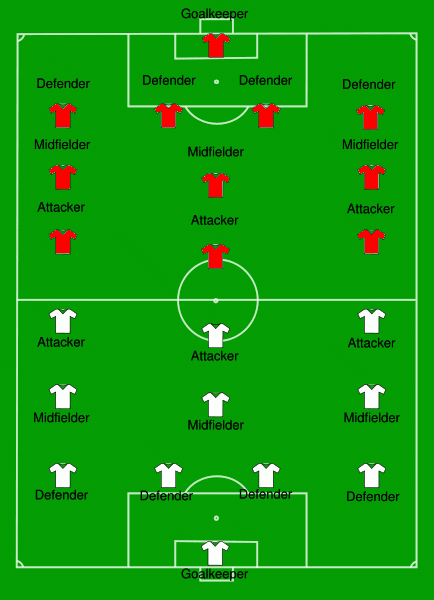- Soccer is known as football in many countries of the world.
- It is known as the most popular team game in the world.
- The first game resembling current soccer was played at Trinity College in Cambridge, England in 1848.
- Today, rules are determined by the International Football Association Board (IFAB); this organization was formed in 1882.
- There is evidence that a game involving kicking a ball into a small net, was used by the Chinese military during the Han Dynasty – around the 2nd and 3rd centuries BC (almost 2000 years ago).
Objective: The team that scores the most goals wins. A draw occurs if the teams have an equal number of goals. A goal is scored when the whole ball is passed completely across the goal line between the goal posts and beneath the cross bar.
Overview
- A soccer game, or match, is played between 2 teams of 11 players (up to 15 players).

- One player is designated as the goalkeeper and they defend the goal using any part of their body, including their hands (when inside the penalty area).
- Field players may not use their hands, but may use their feet, legs, heads and bodies.
- Soccer is played on a field called the pitch.
- Formations (positions of play) vary from team to team, most have the field divided into 3 areas to cover; for example 4 forward, 3 mid-fielders and 3 defenders.
There is a set of rules called the Laws of the Game that consist of 17 Laws. Some rules pertaining to the size of the field, goal, ball, or duration of play can be modified for younger players.
- The dimensions of the field are set
- The size and weight of the ball are set.
- Start of game is determined by a coin toss
- Team that wins possession begins with a kickoff from center to a teammate (other players must be positioned outside the center circle within their own half of the pitch).
- A kickoff, or placekick, is made after a goal (defenders take possession).
- The ball is ‘out of play’ when it completely crosses a touchline, or goal line, or when a referee calls it ‘out’.
- A ball that is ‘out’ at a sideline, such that…
- the ball is returned to play by the other team with a throw-in, and
- the player delivers the ball to the pitch with an overhead throw with both feet on the ground, and
- the ball must be delivered to another player (they can’t throw it, then chase it in).
- a goal may not be scored directly from a throw-in.
- When the offense puts a ball ‘out’ on the goal line, it is returned to play by the goalie with a goal kick where…
- a goal kick must be made to another player, and
- opposition players must be located outside of the penalty area, and
- a goal cannot be made directly from a goal kick.
- A ball ‘out’ on the goal line, by the defense, is returned to play by a corner kick.
- The ball is ‘in play’ even if it rebounds from the goal post, crossbar, corner, or ref or linesmen when they are on the field.
- When a ref is unsure of which team last had possession, or if there was an injury, the play may be restarted with a drop ball at that point in the field (can’t kick the ball until it touches the ground).
- A goal is scored when the whole ball passes into the goal (over the line, between the posts, under the cross bar) as long as it was not propelled there by an arm or hand. Each goal counts as one point.
- The referee officiates the game, and may be assisted by 2 assistant referees and or linesmen.
Fouls and Penalties
Fouls and misconduct are penalized with direct free kicks, indirect free kicks and penalty kicks.
- A direct kick is awarded when a major foul occurs. The fouled player shoots at the goal from the place where the foul occurred and defensive players must be 10 yards (9.14m) away. Major fouls include: handling the ball, kicking-striking-tripping-holding-grasping-pushing-charging (any non-sporting behaviour) with an opponent intentionally.
- An indirect kick is awarded for a minor foul. The fouled player passes to a teammate before a shot on goal may be taken. Minor fouls include dangerous play, obstruction, the goaltender taking more than 4 steps with the ball in their hands, or offsides.
- Offside: a player is in an offside position when they are nearer the opponent’s goal line than the ball is at the moment the ball is played unless,
- the player is in their own ½ of the pitch
- two opponents are even closer to their own goal line
- A penalty kick, occurs when the defensive team commits a major foul in the penalty area. The offensive team member takes a shot on goal from the penalty spot and only the goaltender is allowed to defend the goal.


Thanks